ALLIES SHUT DOWN GERMANY’S NORDWIND, OPEN OWN OFFENSIVE
SHAEF HQ, Versailles, France • January 29, 1945
On this date in 1945 Allied armies in Western Europe returned to the offensive after having shut down Nazi Germany’s Operation Nordwind (German, Unternehmen Nordwind) 4 days earlier. Nordwind was the last major German offensive of World War II on the Western Front. It began on the last day of December 1944 in what is today Rhineland-Palatinate in Southwestern Germany and Alsace-Lorraine in Northeastern France. Much of Alsace-Lorraine had been incorporated into the Greater German Reich after the Franco-German armistice of 1940. Nordwind ended on January 25, 1945, the same day Allied armies ended Adolf Hitler’s ill-fated Ardennes Offensive, known in the West as the Battle of the Bulge and in Germany as Unternehmen Wacht am Rhein, Operation Watch on the Rhine.
Operation Nordwind is sometimes referred to as the “other” Battle of the Bulge. The more well-known of the 2 battles of the bulge took place in the Ardennes region of Belgium, Northeastern France, and Luxembourg. Its objective was to have the German Wehrmacht (armed forces) dash up the seam between the U.S. and Anglo-Canadian armies, ripping it in two, seize the Allies’ major supply port, the Belgian port of Antwerp 100 miles/161 km west of the front lines, inflict crushing casualties on the Allied side, and force a negotiated settlement friendly to Germany. Similarly, Nordwind in Northeastern France had as its objective to break through the lines of Gen. Jacob Devers’ Sixth Army Group, comprising the U.S. Seventh Army and the French First Army operating in the Upper Vosges Mountains and the Alsatian Plain. Once that was accomplished, the plan was to annihilate the 2 enemy armies and retake Strasbourg, France’s largest city on the Rhine River, across from which lay Nazi Germany itself (see map below for the locations of the 2 bulges). This destruction would open a path for another major Wehrmacht thrust (Unternehmen Zahnartz, Operation Dentist), this into the rear of Lt. Gen. George S. Patton’s U.S. Third Army redeployed to the Ardennes, and potentially lead to, as Hitler told his division commanders on December 28, 1944, “exterminating the enemy forces wherever we find them.”
The twin late-war German counteroffensives aimed at halting the Allied advance into the German homeland were breathtaking in scope and audacity. Alas, for Hitler’s Thousand Year Reich the Western offensives ended in German losses in manpower, equipment, and morale that could never to be recovered. On January 29, 1945, Allied armies in Alsace returned to the offensive. Early in March U.S. and French units linked up in the center of the Colmar Pocket, the now abandoned German bridgehead that had stretched 50 miles/80 km along the Rhine’s western banks south of Strasbourg. As Wehrmacht units withdrew to safety east of the Rhine, Patch’s Seventh Army began a drive just over a week later to clear Northeastern Alsace of the enemy, and at month’s end had secured a foothold on German soil. Like the Battle of the Bulge, Operation Nordwind sowed considerable confusion among Allied fighting units, added weeks to the inevitable capitulation of Hitler’s Germany, and generated huge numbers of killed, wounded, or missing: between 19,268 and 27,000 on the U.S. and French side and between 45,000 and 61,500 on the German side (figures include Colmar Pocket casualties).
Operation Nordwind, Germany’s Last Major Offensive of World War II on the Western Front
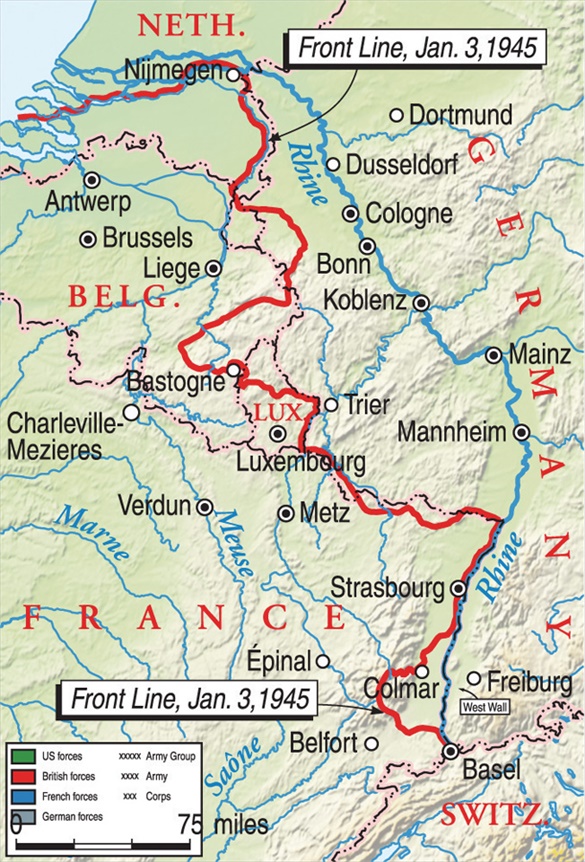 |
Above: This map shows German forces swelling the Ardennes “bulge” (northern bulge on map) between December 16, 1944, and early January 1945. The Allies crushed the Ardennes bulge in late January 1945. On New Year’s Eve 1944, 2 German armies, the First and Nineteenth, launched a major offensive in France’s Alsace-Lorraine, Operation Nordwind, against the thinly stretched 68‑mile/109‑km front line held by the understrength U.S. Seventh Army on SHAEF’s southern flank. The Seventh Army’s Lt. Gen. Alexander Patch had rushed troops, equipment, and supplies north to reinforce American armies in the Ardennes (Battle of the Bulge). SHAEF’s Supreme Allied Commander, Gen. Dwight D. Eisenhower, fearing entrapment of Patch’s 400,000 soldiers, dispatched ammunition and reinforcements to the southern bulge. They began trickling in on January 5, the day Germany’s Operation Nordwind ground to a halt: German divisions were suddenly needed on the Eastern Front. Strasbourg in Northern Alsace was saved by Gen. Jean de Lattre de Tassigny’s French First Army, but the semicircular Colmar Pocket (French, Poche de Colmar) in Central Alsace remained a thorn in the Allies’ side until it was removed in the second week of February 1945 when U.S. and French forces linked up.
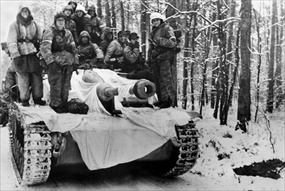 | 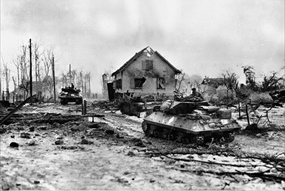 |
Left: German infantrymen, some with white helmets, ride into battle atop a tank destroyer (Sturmgeschuetz) covered with white sheets to blend with the snow. The photo was probably taken northwest of Strasbourg near Haguenau, the scene of bitter fighting during Operation Nordwind.
![]()
Right: Two Allied tank destroyers manned by French troops rumble through war-ravaged streets of Bettenhoffen on their way to Gambsheim near Strasbourg, where German forces had brought in fresh formations from east of the Rhine. On January 25, 1945, the day the Germans suspended Operation Nordwind, the Allies controlled all of Alsace-Lorraine except for a strip of the northeastern corner of France around Gambsheim and the Colmar Pocket to the south.
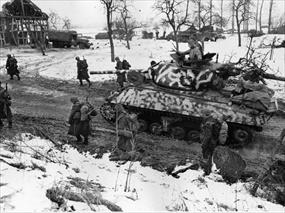 | 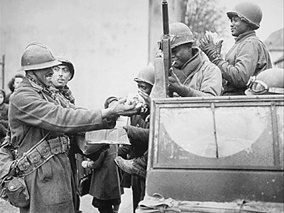 |
Left: Infantrymen accompany a camouflaged Sherman tank on a snowy, muddy road during the Allied advance on the Colmar Pocket in January 1945. In late January and early February, the French First Army, reinforced by the U.S. XXI Corps, a unit of the Patch’s Seventh Army, cleared the Pocket of German forces. Both armies were part of Devers’ U.S. 6th Army Group.
![]()
Right: Two smiling French Moroccans with the French First Army pass candy to African American soldiers in a Jeep in Rouffach, south of the town of Colmar, on February 5, 1945, after their combined units had collapsed the Colmar Pocket.
Silent Footage from Operation Nordwind, Alsace-Lorraine, Northeastern France, January 1945
![]()

 History buffs, there is good news! The Daily Chronicles of World War II is now available as an ebook for $4.99 on Amazon.com. Containing a year’s worth of dated entries from this website, the ebook brings the story of this tumultuous era to life in a compelling, authoritative, and succinct manner. Featuring inventive navigation aids, the ebook enables readers to instantly move forward or backward by month and date to different dated entries. Simple and elegant! Click
History buffs, there is good news! The Daily Chronicles of World War II is now available as an ebook for $4.99 on Amazon.com. Containing a year’s worth of dated entries from this website, the ebook brings the story of this tumultuous era to life in a compelling, authoritative, and succinct manner. Featuring inventive navigation aids, the ebook enables readers to instantly move forward or backward by month and date to different dated entries. Simple and elegant! Click 











